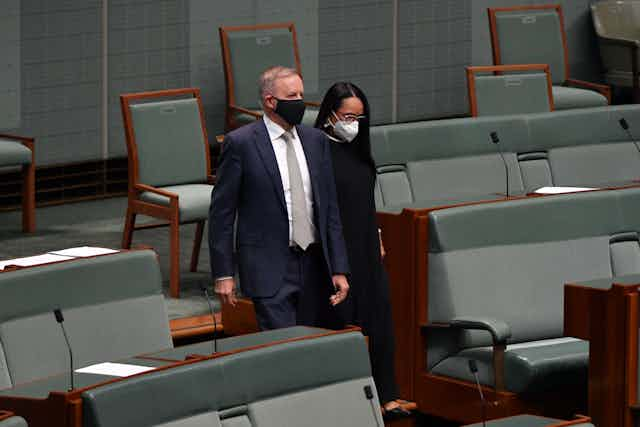Prime Minister Anthony Albanese’s acceptance speech opened with a generous acknowledgement of Traditional Owners and a full commitment to the Uluru Statement from the Heart.
The new government also celebrates the first female Minister for Indigenous Affairs, Linda Burney, as another significant and historic occasion.
Albanese’s commitment to the Uluru Statement from the heart made it clear it is an exciting time to be an Aboriginal or Torres Strait Islander person and participate in building our democracy.
No other election victory speech has placed Indigenous Peoples as central to the incoming government’s policy. Labor’s win thus represents a positive turning point in the relationship between Indigenous Peoples and other Australians.
What does this mean for an Indigenous Voice to Parliament?
An Indigenous Voice to Parliament and Government is one of three aspects of the Uluru Statement, alongside truth-telling and Treaty.
In 2020 I sat on the National Co-Design Group for Indigenous Voice. This was the federal government consultative process that put together the framework for how Indigenous peoples could have a say in parliament and government. Across 2020 and 2021, the working groups for Indigenous Voice heard from almost 9,500 Indigenous and other Australians who offered their thoughts on how a Voice to Parliament might work in practice.
Yet, Labor’s track record in living up to the big policy and social moments is patchy. For example, the 2008 National Apology for Stolen Generations was a bold move to recognise the trauma of colonisation in separating families.
However since that speech, there has been significant increase of Indigenous children in out of home care. This growth jumped in 2008 with the establishment of Close the Gap and has been a consistent trend throughout the Labor and Liberal years since the Apology.
Two options
Instituting an Indigenous Voice under Labor can go one of two ways.
Labor could implement the framework for Indigenous Voice designed by Aboriginal and Torres Strait Islander leaders. Our design was tested in wide-ranging public feedback from both Indigenous and non-Indigenous people. This can be implemented without the need for constitutional reform. This Voice to Parliament would not depend on anything more than the creation of an Act of parliament. This would constitute a national Indigenous body that represents local and regional Indigenous Voices from country to city.
The other pathway is constitutional enshrinement of an Indigenous Voice, which would require a referendum.
We do not need to have constitutional enshrinement of an Indigenous Voice to begin the process of government and parliament deeply listening to Indigenous Peoples for equity in decision-making. Indeed, it is better that we hold off on enshrinement and let the establishment of Indigenous Voice work out the foundations of a historic relationship between Indigenous Peoples and the rest of Australia.
I am full of hope that Indigenous Voice to Parliament and Government will be a powerful example of how we maintain democracy in Australia. If a parliament and government is from the people and for a people, then Indigenous Voice is a perfect place to test how we hear and respond to issues that are representative. Indigenous Voice is not a third chamber, but rather the process in which our gaps of relationship-building are filled.
Hope for the future
People are hurting, through fire, flood or pandemic, and the previous government have badly let us down in addressing this. Politics is not just the act of leadership - Indigenous Voice can be a place where harmonious and practical advice can demonstrate how working together has mutual benefits.
It is exciting to think how far we might come as an Australian population when we look to Indigenous-led processes of inclusion as a model for those other marginalised voices. It is this basis of a healthy and connected relationship to each other, and to Country, that we might have the makings of reaching a democratic fullness of parliament and government.
This election has been surprising, because we could not assume obvious winners in the choice of multiple opinions, parties, independents and positions. What has been beautiful is the idea that an Indigenous Voice is no longer a wedge issue, but something genuine of our Australian character to stand for – a right to have a fair go.

